
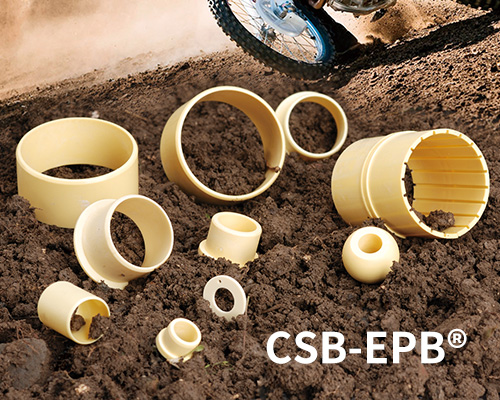
● Low friction and high wear resistance. It could maintain a good stable wear resistance and friction factor for the rotation, linear and oscilation movement. It has no critical hardness requirement to the shaft
● Continuous working temperature: -50℃/+90℃
● Maintenance-free dry operation
● Small wear off amount against various shaft materials
● Lower friction
● Suitable for soft shaft
● Low water absorption
Material properties | Standard | Unit | CSB-EPB13 |
General properties | |||
Color | - | - | Yellow |
Density | ISO1183 | g/cm3 | 1.48 |
Max. moisture absorption, 50%RH | ISO62 | % | 0.3 |
Max. water absorption | ISO62 | % | 1.3 |
Coefficient of sliding friction(steel) | ITS025 | µ | 0.05-0.15 |
Max. PV value | ITS026 | N/mm2×m/s | 0.40 |
Mechanical properties | |||
Flexural modulus | ISO178 | MPa | 2600 |
Flexural strength | ISO178 | MPa | 60 |
Max. static load | ITS027 | MPa | 35 |
Max. dynamic load | ITS028 | MPa | 14 |
Shore hardness | ISO868 | D | 74 |
Physical and thermal properties | |||
Long-term application temperature | ITS029 | ℃ | +90 |
Short-term application temperature | ITS029 | ℃ | +120 |
Lowest application temperature | ITS029 | ℃ | -50 |
Thermal conductivity | ISO22007 | W/m/K | 0.25 |
Coefficient of thermal expansion | ISO11359 | K-1×10-5 | 10 |
Flammability | UL94 | Class | HB |
Electrical properties | |||
Volume resistance | IEC60093 | Ω·cm | >1013 |
Surface resistance | IEC60093 | Ω | >1012 |
*ITS: CSB company's internal test standards. **Test temperatures are 23℃ unless otherwise stated.
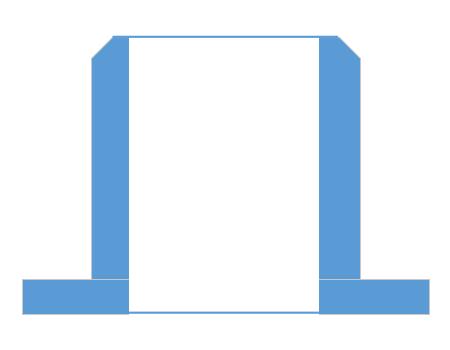

The max PV value of the CSB-EPB13 plastic bearings is 0.4N/mm2×m/s which determines the load capacity of bearing is inversely proportional to the speed. Please refer to the chart for more detailed information (Graph EPB13-1).
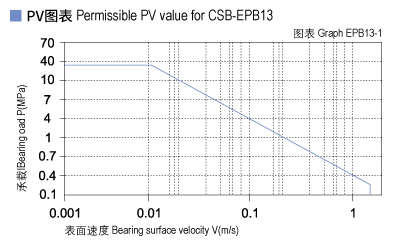
CSB-EPB13 allows the Max static load of 35Mpa, The max compressive deformation rate under the max load is listed in Graph EPB13-2, The actual load capacity of bearing is slightly less than 35Mpa, The bearing load is variable against the speed and temperature, Fast speed (Vmax: 1.5m/s) results into higher temperature (Tmax: 90℃) which decreases the load capacity of the bearing. Please refer to the Graph EPB13-3 for such variation.
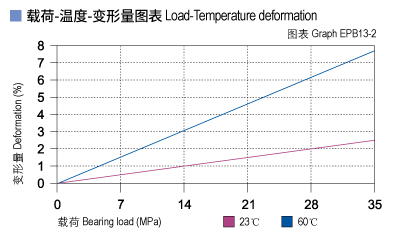
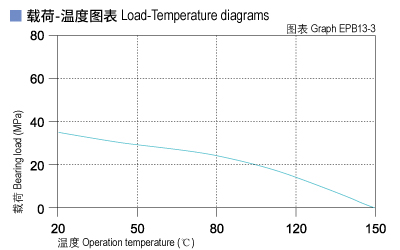
CSB-EPB13 Bearing friction factor varies only little amount along with the operation speed changing (See Graph EPB13-4). When the operation speed is relatively stable, the friction factor varies a lot while the load is less than 10Mpa (see Graph EPB13-5). At the same time, it does not vary much when the loading is greater than 10Mpa. Rough surface may result into the increasing of friction factor of the CSB-EPB13 material but when the roughness of the surface is greater than Ra0.5, the friction factor will remain relatively stable again. The recommended shaft surface roughness is Ra0.1~Ra0.4 for the CSB-EPB13 material.
| CSB-EPB13 | Dry | Grease | Oil | Water |
| Friction coef. μ | 0.05~0.15 | 0.09 | 0.04 | 0.04 |
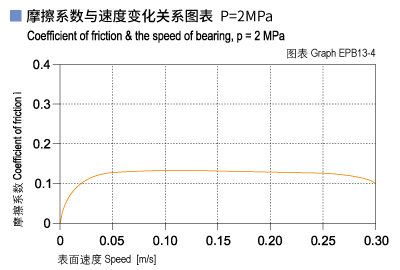
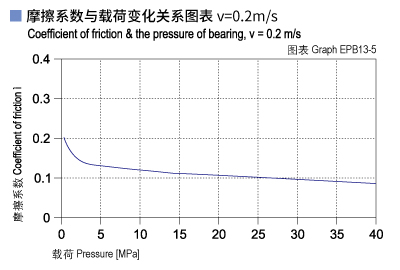
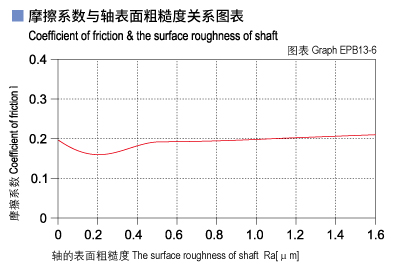
Test of the bearing against various shaft materials shows that the material CSB-EPB13 features the best performance where the shaft material is hard chrome steel with loading less than 2Mpa. (See Graph EPB13-7). Therefore, the higher the load is increased, the wear-resistance of the bearing will be better against the stainless steel shaft. Refer to Graph EPB13-7, the material CSB-EPB13 is suitable for rotation operation. Ether to be used under rotation operation or the oscillation operation, it is the best suitable material for the application against hard chrome steel shaft.
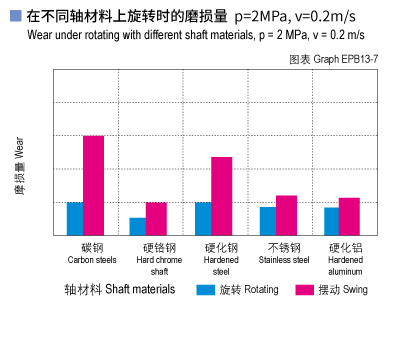

CSB-EPB13 is good at chemical resistance against mild base, weak acidic medium and various kinds of lubricants.
The moisture absorption of CSB-EPB13 plastic bearings is 0.3% in standard atmosphere. The max. water absorption is 1.3% in water. These values are so low that design changes due to absorption are only necessary in extreme applications.
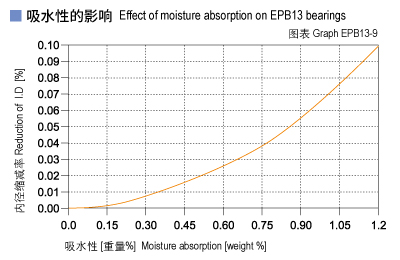
CSB-EPB13 can maintain its color unchanged when it is exposed into the UV ray. The hardness, Compressive strength and wear resistance of the material is also stable under such condition.
CSB-EPB13 bushing tolerances after pressfit
Diameter [mm] | Inner diameter E10 [mm] | Housing H7 [mm] | Shaft h9 [mm] |
>0~3 | +0.014~+0.054 | 0~+0.010 | 0~-0.025 |
>3~6 | +0.020~+0.068 | 0~+0.012 | 0~-0.030 |
>6~10 | +0.025~+0.083 | 0~+0.015 | 0~-0.036 |
>10~18 | +0.032~+0.102 | 0~+0.018 | 0~-0.043 |
>18~30 | +0.040~+0.124 | 0~+0.021 | 0~-0.052 |
>30~50 | +0.050~+0.150 | 0~+0.025 | 0~-0.062 |
>50~80 | +0.060~+0.180 | 0~+0.030 | 0~-0.074 |
>80~120 | +0.072~+0.212 | 0~+0.035 | 0~-0.087 |
>120~180 | +0.085~+0.245 | 0~+0.040 | 0~-0.100 |
▊CSB-EPB® Plastic Bearings Finder[V2.1] is based on the analysis and calculation of a large number of test data in CSB® laboratory. You can calculations material data by entering parameters such as bearing load, speed, and temperature, and finally output material adaptation data.
▊Because the system calculate and analyze based on lab data, it can't exactly meet the ractual use requirements absolutly. The system data verification has certain limitations; CSB® recommends that the bearing must be tested again to verify whether it meets the actual use requirements.
▊CSB-EPB® Plastic Bearings Finder output data information is only for design reference, and can not be used as the final standard for determining the bearing material conformity, If you have any questions, please contact CSB® sales engineers.
▊DURAPLAS® Semi-finished Products Finder[V2.0] is based on the analysis and calculation of a large number of test data in CSB® laboratory. You can calculations material data by entering parameters such as bearing load, speed, and temperature, and finally output material adaptation data.
▊Because the system calculate and analyze based on lab data, it can't exactly meet the ractual use requirements absolutly. The system data verification has certain limitations; CSB® recommends that the products must be tested again to verify whether it meets the actual use requirements.
▊DURAPLAS® Semi-finished Products Finder output data information is only for design reference, and can not be used as the final standard for determining the bearing material conformity, If you have any questions, please contact CSB® sales engineers.
| Medium | EPB13 bearings resistance |
| Alcohol | Resistant |
| Hydrocarbons | Resistant |
| Greases. oils | Resistant |
| Fuels | Resistant |
| Diluted acids | Conditionally resistant |
| Strong acids | Not resistant |
| Diluted alkalis | Resistant |
| Strong alkalis | Conditionally resistant |
Please select bearing material and medium...
▊CSB® bearing material chemical resistance data is a comparison test result of the CSB chemistry laboratory using laboratory specimens or similar chemicals at room temperature 23 ℃, without considering the impact of other temperatures and chemical medium mixtures on the chemical resistance of CSB® bearing materials ; Therefore, this data can only act as a reference. CSB® recommends that the chemical resistance of actual parts should be tested under application conditions and verify the suitability of the bearings.
The self-lubricated bearing is developed specially for the metal plate fitting. It is made with the CSB-EPB3M material which is good at shock absorbtion and wear resistance...
moreThin-walled plastic bearing for quick installation. It is made with CSB-EPB3M material wich is flexible for dimension viriation. Alternative material CSB-EPB7 is also available for special wear resistance requirement.
more● Clearance-free and preload design
● Adjustable fitting gap
● Maintenance-free
● Shock absorbing and no noise
Suitable for the application where the CSB® plastic clip bearing is hard to be located. The requirement of the fitting hole is not critical and the set screw could be secured without any risk of moving.
moreCSB® plastic wear resistance washer. Suitable for a fitting to the uncontrollable axial space in order to reduce the vabriation and noise during the operation.
moreWear resistance piston ring specially developed for the pneaumatic pump industrial application. It is easier to be installed comparing with the PTFE piston ring. Standard materials available are EPB13, EPB19 and so on.
more● Made of high anti-wear material EPB13;
● Maintenance-free, self lubricating;
● Chemical resistant;
● Dust resistant and quit running;
Self-lubricating, maintenance-free Low driving force Resistant to dust...
more